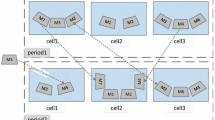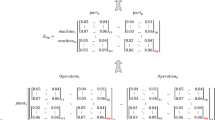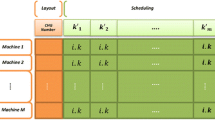Abstract
This paper presents a dynamic multi-objective mixed integer mathematical model for cell formation problem with probabilistic demand and machine reliability analysis, where the total system costs, machine underutilization cost, and maximum system failure rate over the planning time periods are to be minimized simultaneously. The total system cost objective function calculates machine operating, internal part production, intercellular material handling, and subcontracting costs. Since in this type of problems, objectives are in conflict with each other, so finding an ideal solution (a solution that satisfies all objectives simultaneously) is not possible. Therefore, this study uses the augmented ε-constraint method (to solve small size problems) and a nondominated sorting genetic algorithm (NSGAII) (to solve large size problems) to find the Pareto optimal frontier that decision makers can select her/his preferred solution. Numerical examples will be solved to demonstrate the efficiency of the proposed algorithm.
Similar content being viewed by others
References
Wemmerlov U, Hyer N (1989) Cellular manufacturing in the US industry: a survey of users. Int J Prod Res 27(9):1511–1530
Mansouri SA, Moattar-Husseini SH, Zegordi SH (2003) A genetic algorithm for multiple objective dealing with exceptional elements in cellular manufacturing. Prod Plan Control 14(5):437–446
Song S-J, Choi J-H (2001) Integrated autonomous cellular manufacturing: a new concept for the 21st century. Int J Manuf Technol Manag 3:293–307
Lockwood W, Mahmoodi F, Mosier C (2000) Scheduling unbalanced cellular manufacturing systems with lot splitting. Int J Prod Res 38:951–966
Schaller JE, Erenguc SS, Vakharia AJ (2000) A mathematical approach for integrating the cell design and production planning decision. Int J Prod Res 38:3953–3971
Chen M (2001) A model for integrated production planning in cellular manufacturing systems. Integr Manuf Syst 12:275–284
Nsakanda AL, Diaby M, Price WL (2006) Hybrid genetic approach for solving large-scale capacitated cell formation problems with multiple routings. Eur J Oper Res 171:1051–1070
Chen M, Cao D (2005) A robust cell formation approach for varying product demands. Int J Prod Res 49(8):1587–1605
Chen M, Cao D (2004) Coordinating production planning in cellular manufacturing environment using Tabu search. Comput Ind Eng 46:571–588
Saidi-Mehrabad M, Safaei N (2007) A new model of dynamic cell formation by a neural approach. Int J Adv Manuf Technol 33:1001–1009
Defersha FM, Chen M (2006) Machine cell formation using a mathematical model and a genetic- algorithm-based heuristic. Int J Prod Res 44(12):2421–2444
Kioon SA, Bulgak AA, Bektas T (2009) Integrated cellular manufacturing systems design with production planning and dynamic system reconfiguration. Eur J Oper Res 192:414–428
Mahdavi I, Aalaei A, Paydar MM, Solimanpur M (2010) Designing a mathematical model for dynamic cellular manufacturing systems considering production planning and worker assignment. Comput Math with Appl. doi:10.1016/j.camwa:03.044
Rafiee K, Rabbani M, Rafiei H, Rahimi-Vahed A (2011) A new approach towards integrated cell formation and inventory lot sizing in an unreliable cellular manufacturing system. Appl Math Model 35:1810–1819
Khaksar-Haghani F, Kia K, Mahdavi I, Kazemi M (2013) A genetic algorithm for solving a multi-floor layout design model of a cellular manufacturing system with alternative process routings and flexible configuration. Int J Adv Manuf Technol 66(5–8):845–865
Renzi C, Leali F, Cavazzuti M, Andrisano AO (2014) A review on artificial intelligence applications to the optimal design of dedicated and reconfigurable manufacturing systems. Int J Adv Manuf Technol. doi:10.1007/S00170-014-5674-1
Solimanpur M, Saeedi S, Mahdavi I (2010) Solving cell formation problem in cellular manufacturing using ant-colony-based optimization. Int J of Adv Manuf Technol 50(9–12):1135–1144
Moslemipour G, Lee TS, Rilling D (2012) A review of intelligent approaches for designing dynamic and robust layouts in flexible manufacturing systems. Int J Adv Manuf Technol 60(1-4):11–27
Chang, C., C., Wu, T., H., Wu, C.,W (2013) An efficient approach to determine cell formation, cell layout and intracellular machine sequence in cellular manufacturing systems. Computers & Industrial Engineering, Volume 66, Issue 2, Pages 438–450
Jeon G, Leep HR, Parsei HR (1998) Cellular manufacturing system based on new similarity coefficient which considers alternative routes during machine failure. Comput Ind Eng 34(1):21–36
Yazhau J, Molin W, Zhixin J (1995) Probability failures of machining center failures. Reliab Eng Syst Saf 50(1):121–125
Dai Y, Zhou Y-F, Jia YZ (2003) Distribution of time between failures of machining center based on type I censored data. Reliab Eng Syst Saf 79(3):377–379
Seifoddini S, Djassemi M (2001) The effect of reliability consideration on the application of quality index. Comput Ind Eng 40(1–2):65–77
Diallo M, Perreval H, Quillot A (2001) A Manufacturing cell design with flexible routing capability in presence of unreliable machines. Int J Prod Econ 74(1–3):175–182
DAS K, Lashkari RS, Sengupta S (2007) Machine reliability and preventive maintenance planning for cellular manufacturing systems. Eur J Oper Res 183:162–180
Das K (2008) A comparative study of exponential distribution vs Weibull distribution in machine reliability analysis in a CMS design. Comput Ind Eng 54:12–33
Saxena LK, Jain PK (2011) Dynamic cellular manufacturing systems design a comprehensive model. Int J Adv Manuf Technol 53(1):11–34
Zhao C, Wu Z (2000) A genetic algorithm for manufacturing cell formation problem with multiple routes and multiple objectives. Int J Prod Res 38(2):385–395
Suresh NC, Slomp J (2001) A multi-objective procedure for labor assignments and groping in capacitated cell formation problem. Int J Prod Res 39:4103–4131
Arzi Y, Bukchin J, Masin M (2001) An efficient frontier approach for the design of cellular manufacturing systems in a lumpy demand environment. Eur J Oper Res 134:346–364
Khoo LP, Lee SG, Yen XF (2003) Multi-objective optimization of machine cell layout using genetic algorithm. Int J Comput Int Manuf 16:140–155
Mansouri SA, Moattar-Husseini SH, Zegordi SH (2003) A genetic algorithm for multiple objective dealing with exceptional elements in cellular manufacturing. Prod Plann & Control 14(5):437–46
Yasuda K, Hu L, Yin Y (2005) A grouping genetic algorithm for the multi-objective cell formation problem. Int J Prod Res 43(4):829–53
Lei D, Wu ZH (2005) Tabu search for multiple-criteria manufacturing cell design. Int J Adv Manuf Technol 28:950–956
AramoonBajestani M, Rabbani M, Rahimi-Vahed AR, BaharianKhoshkhou G (2007) A multi-objective scatter search for a dynamic cell formation problem. Comput Oper Res, in press. doi:10.1016/j.cor.10.026
Tavakkoli-Moghaddam R, Rahimi-Vahed AR, Ghodratnama A, Siadat A (2008) A simulated annealing method for solving a new mathematical model of a multi-criteria cell formation problem with capital constraints. Adv Eng Softw 40(4):268–273
Javadian, N., Aghajani, A (2011) A multi-objective integrated cellular manufacturing systems design with dynamic system reconfiguration,International Journal of Advanced Manufacturing Technology: Volume 56, Issue 1 Page 307-317; 34, 35
Shiyas, C.R., Madhusudanan Pillai, V. (2014) A mathematical programming model for manufacturing cell formation to develop multiple configurations. Journal of Manufacturing Systems, Volume 33, Issue 1, January 2014, Pages 149–158
Barzinpour F, Arkat J, Jabal Ameli MS (2008) Modeling the effects of machine breakdowns in the generalized cell formation problem. Int J Adv Manuf Technol 39(7-8):838–850
Collette Y, Siarry P (2003) Multi-objective optimization: principles and case studies. Springer, New York
Ebeling, C. E. An introduction to reliability and maintainability engineering. New York: McGraw-Hill. Flynn, B. B., & Jacobs, F. R. A. (1986). A simulation comparison of group technology with traditional job shop manufacturing. International Journal of Production Research 24(5): 1171–1192
Ross S (1989) A first course in probability, 3redth edn. Macmillan publishing company, New Yourk, 36,37
Cohon JL (1978) Multi objective programming and planning. Academic, New York
Mavrotas G (2009) Effective implementation of the ε-constraint method in multi-objective mathematical programming problems. Appl Math Comput 213:455–465
Deb K, Pratap A, Agarwal S, Meyarivan T (2002) A fast and elitist multi-objective genetic algorithm: NSGA-II. IEEE Trans Evol Comput 6(2):182–197
Zitzler E (1999) Evolutionary algorithms for multi-objective optimization: methods and applications, Doctoral dissertation ETH 13398, Swiss Federal Institute of Technology (ETH), Zurich, Switzerland, 33, 66
Author information
Authors and Affiliations
Corresponding author
Rights and permissions
About this article
Cite this article
Aghajani, A., Didehbani, S.A., Zadahmad, M. et al. A multi-objective mathematical model for cellular manufacturing systems design with probabilistic demand and machine reliability analysis. Int J Adv Manuf Technol 75, 755–770 (2014). https://doi.org/10.1007/s00170-014-6084-0
Received:
Accepted:
Published:
Issue Date:
DOI: https://doi.org/10.1007/s00170-014-6084-0




